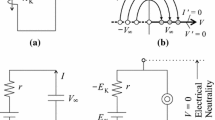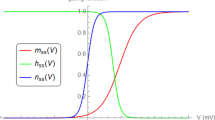Abstract
Alan Hodgkin’s and Andrew Huxley’s mid-20th century work on the ionic currents generating neuron action potentials stands among that century’s great scientific achievements. Unsurprisingly, that case has attracted widespread attention from neuroscientists, historians and philosophers of science. In this paper, I do not propose to add any new insights into the vast historical treatment of Hodgkin’s and Huxley’s scientific discoveries in that much- discussed episode. Instead, I focus on an aspect of it that hasn’t received much attention: Hodgkin’s and Huxley’s own assessments about what their famous “quantitative description” accomplished. The “Hodgkin-Huxley model” is now widely recognized as a foundation of contemporary computational neuroscience. Yet Hodgkin and Huxley expressed serious caveats about their model and what it added to their scientific discoveries, as far back as their (1952d), in which they first presented their model. They were even more critical of its accomplishments in their Nobel Prize addresses a decade later. Most notably, as I argue here, some worries they raised about their quantitative description seem still to be relevant to current work in ongoing computational neuroscience.


Similar content being viewed by others
Notes
“The Nobel Prize in Physiology or Medicine 1963,” https://www.nobelprize.org/prizes/medicine/1963/summary/.
“Presentation speech by Professor R. Granit,”
https://www.nobelprize.org/prizes/medicine/1963/ceremony-speech/ All quotes from Granit in this paper are from his Presentation speech.
I thank a first anonymous reviewer for a comment that helped me clarify what this investigation contributes to the history of science.
Hodgkin volunteered for British Aviation Medicine and eventually was transferred to Telecommunications Research, developing RADAR devices. Huxley was recruited by and served in the British Anti-Aircraft Command. Different times.
In his Nobel Address, Hodgkin also credits Huxley for being involved in this work (Hodgkin 1963, p. 37). At the end of Hodgkin and Katz (1949) the authors “express our gratitude … to Mr. A.F. Huxley for much helpful and stimulating discussion.” I suspect a story lurks behind why Huxley wasn’t included as an author on that paper, although I have not found it.
Fig. 2 Hodgkin’s and Huxley’s variation on Cole and Marmont’s voltage clamp. Diagram from Huxley (1963), adapted from Hodgkin et al. (1952). Huxley’s caption reads: “Schematic diagram of a voltage clamp apparatus. The axon is immersed in sea water, and the horizontal lines represent partitions in a box made of insulating material which guided the current flow. Potential difference across membrane measured between wires b and c; current passed from wire a to electrode e. Current through middle section of nerve measured as potential drop in sea water between wires c and d.” (1963, p. 53)
Their refinements to the voltage clamp were not the first instance of Hodgkin’s and Huxley’s cleverness and deftness in manipulating wetlab instrumentation in order to obtain clean data, that their contemporaries greatly admired, and which were subsequently adopted worldwide in experimental practice. Luis Favela (private correspondence) reminded me of a passage in one of Hodgkin and Huxley’s earlier publications, prior to their work with the voltage clamp, where they speak of their own refinements to recording membrane potentials from the Loligo giant axon. They describe inserting an extra mirror into the micromanipulator carriage for the second electrode, which ensured that the second electrode would not make contact with the nerve fiber surface. So noted!
Any good neurobiology textbook will contain a description and illustration of the two-electrode variation of the voltage clamp. Numerous photographs, illustrations and video tutorials can be found on the internet.
All citation information taken from PubMedCentral (PMC), https://www.ncbi.nlm.nih.gov/pmc/, last queried 12/30/2022.
Recently Evan Pence (2017) has criticized the new mechanist interpretation of the Hodgkin-Huxley quantitative model which contends that, while the model is an excellent predictive tool, it does not provide a causal explanation of the action potential; that it is a descriptive phenomenological model expressed in a mathematically convenient form; and that Hodgkin and Huxley themselves defended this status for their model. Pence counters this interpretation by arguing that Hodgkin and Huxley interpreted their model causally, used a method to arrive at the conductance terms in their model that carried important causal implications, and indeed explained the action potential with their model “in the fashion they conceived of it” (2017, p. 1178). Interesting as this debate is, especially since passages in dispute between Pence and new mechanists include some that I will cite and discuss below, I will not take a stand on this dispute in this paper. As I just emphasized, I am interested specifically in Hodgkin and Huxley’s own explicit assessments about what their quantitative model did and did not accomplish. The fate of and fallout for new mechanism is not my concern (here).
Prior to his Cambridge appointment, Ronald Aylmer (R.A.) Fisher’s early work revolutionized the nature of scientific experimentation by focusing on experimental design, statistical models, and possible outcomes prior to data collection. He popularized the use of alpha-level, p-value and many other statistical notions. He was a founder of population genetics. His use of mathematics to combine Mendelian genetics and Darwinian natural selection contributed to their “modern synthesis.” David Colaço (private correspondence) suggested to me another intriguing hypothesis for why Hodgkin and Huxley developed their quantitative model: the numerous advances in electrical engineering that occurred around the time of World War II. He noted that their quantitative description looks suspiciously like the electrical engineering models of that era. Hodgkin’s and Huxley’s wartime activities would have exposed them to these developments. So noted!
I thank a second anonymous reviewer for calling my attention to Huxley (1957). Clearly there is an equally rich vein in that paper and its citation path for exploring the kind of self-assessment of their work by hugely influential scientists that may not line up with the popular legacy of their achievements. But a full development of that case needs to be done by someone better versed in the details of muscle tissue structure and function, and its history, than me.
Thanks to Louis Favela and David Colaço (private correspondences, independently) for reminding me of the diversity of goals and research projects in contemporary computational neuroscience.
References
Baylor, D., & Yau, K. W. (1999). Sir Alan Lloyd Hodgkin 1914–1998. Nature Neuroscience, 2/2, 111.
Bickle, J. (2022). Tinkering in the lab. In J. Bickle, C. F. Craver, & A. S. Barwich (Eds.), The tools of neuroscience research: Philosophical and scientific perspectives. (pp. 13–36). Routledge.
Catterall, W. A., Raman, I. M., Robinson, H. P. C., Sejnowski, T. J., & Paulsen, O. (2012). The Hodgkin-Huxley heritage: From channels to circuits. Journal of Neuroscience, 32(41), 14064–14073.
Cole, K. S. (1949). Dynamic electrical characteristics of the squid axon membrane. Archives des Sciences Physiologiques, 3, 263–258.
Favela, L. H. (2021). “It takes two to make a thing go right”: The coevolution of technical and mathematical tools in neuroscience. J. Bickle, C. F. Craver, & A. S. Barwich (Eds.), The tools of neuroscience experiment: Philosophical and scientific perspectives. (287–304). Routledge.
Haüsser, M. (2000). The Hodgkin-Huxley theory of the action potential. Nature Neuroscience, 3/11, 1165.
Hodgkin, A. L. (1963). The ionic basis of nervous conduction. https://www.nobelprize.org/uploads/2018/06/hodgkin-lecture.pdf
Hodgkin, A. L., & Huxley, A. F. (1939). Action potentials recorded from inside a nerve fibre. Nature, 144(1939). 710–711.
Hodgkin, A. L., & Huxley, A. F. (1952a). Current carried by sodium and potassium ions through the membrane of the giant axon of Loligo. Journal of Physiology, 116, 449–472.
Hodgkin, A. L., & Huxley, A. F. (1952b). The components of membrane conductance in the giant axon of Loligo. Journal of Physiology, 116, 473–496.
Hodgkin, A. L., & Huxley, A. F. (1952c). The dual effect of membrane potential on sodium conductance in the giant axon of Loligo. Journal of Physiology, 116, 497–506.
Hodgkin, A. L., & Huxley, A. F. (1952d). A quantitative description of membrane current and its application to conductance and excitation in nerve. Journal of Physiology, 117, 500–544.
Hodgkin, A. L., & Katz, B. (1949). The effect of sodium ions on the electrical activity of the giant axon of the squid. Journal of Physiology, 108, 37–77.
Hodgkin, A. L., Huxley, A. F., & Katz, B. (1952). Measurement of current-voltage relations in the giant axon of Loligo. Journal of Physiology, 116, 424–448.
Huxley, A. F. (1957). Muscle structure and theories of contraction. Progress in Biophysics and Biophysical Chemistry, 7, 255–318.
Huxley, A. F. (1963). The quantitative analysis of excitation and conduction in nerve. https://www.nobelprize.org/uploads/2018/06/huxley-lecture.pdf
Koch, C. (1997). Biophysics of computation: Information processing in single neurons. Oxford University Press.
Kording, K. P., Blohm, G., Schrater, P., & Kay, K. (2020). Appreciating the variety of goals in computational neuroscience. arXiv (article). https://arxiv.org/pdf/2002.03211.pdf
Marmont, G. (1949). Studies on the axon membrane. Journal of Cellular and Comparative Physiology, 34, 351–382.
Pence, D. E. (2017). Potential controversies: Causation and the Hodgkin-Huxley equations. Philosophy of Science, 84(5), 1177–1188.
Schwiening, C. J. (2012). A brief historical perspective: Hodgkin and Huxley. Journal of Physiology, 590(11), 2571–2575.
Author information
Authors and Affiliations
Corresponding author
Additional information
Publisher’s Note
Springer Nature remains neutral with regard to jurisdictional claims in published maps and institutional affiliations.
Rights and permissions
Springer Nature or its licensor (e.g. a society or other partner) holds exclusive rights to this article under a publishing agreement with the author(s) or other rightsholder(s); author self-archiving of the accepted manuscript version of this article is solely governed by the terms of such publishing agreement and applicable law.
About this article
Cite this article
Bickle, J. Hodgkin’s and Huxley’s own assessments of their “quantitative description” of nerve membrane current. HPLS 45, 25 (2023). https://doi.org/10.1007/s40656-023-00582-7
Received:
Accepted:
Published:
DOI: https://doi.org/10.1007/s40656-023-00582-7





